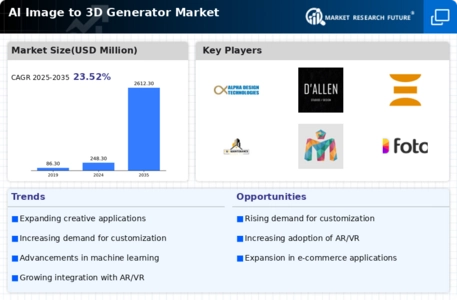Ai Image To 3d Generator Size
AI Image to 3D Generator Market Growth Projections and Opportunities
The Ai image to 3D generators market involves several mechanisms that determine the market growth and the acceptance rate. The driving forces comprise four factors, namely technological developments, the increase of 3D visualization and immersive experiences, the emergence of e-commerce market, and the requirement of speedy and precise 3D modeling.
Technological breakthroughs are among the essential drivers that propel the AI image to 3D generator marketplace. As AI and computer vision technologies progress, AI image to 3D generators get more innovative in understanding and interpreting 2D images into life-like 3D models. These improvements make it possible for AI image generators to really grab the depth, the shape and the actual texture out of simple 2D images, resulting in a better immersive environment. Furthermore, better machine learning algorithms and data processing techniques also enhance the accuracy and efficiency of 3D modeling, which makes AI image to 3D generators more realiable and more accessible. The technological advancements speed up the development of the AI 2D to 3D generator market, because of the development more accuracy and efficiency solutions for converting the 2D images to 3D models.
The very ever-increasing demand for 3D visualizations and immersive experiences is a prominent driver for AI image to 3D generators. Branching out industries such as gaming, architectural, interior decoration and entertainment are now making use of 3D visualization to develop realistic and interactive simulations. AI image to 3D converter automate the process of converting 2D images such as photos or sketches to highly detailed 3D objects. This results in professionals, as well as hobbyists, being able to work with objects and manipulate them in virtual reality, which in turn enables them to enhance their design and creative processes. Clamor for 3D visualization and immersive experiences empowers the adoption of AI image to 3D transformation technology as firms and consumers look for authentic ways of creating 3D models.
The internet retail increases the tendency of AI image to 3D generator market. Along with the rise of online shopping comes the responsibility of making virtual product visualization both realistic and interactive. AI image to 3D generators empowers e-commerce platforms to translate product images into 3D models thereby making it possible for customers to manipulate products from different directions. Thus, more exact product portrayal is conveyed and physical showrooms or in-person demonstrations are not needed anymore.











Leave a Comment